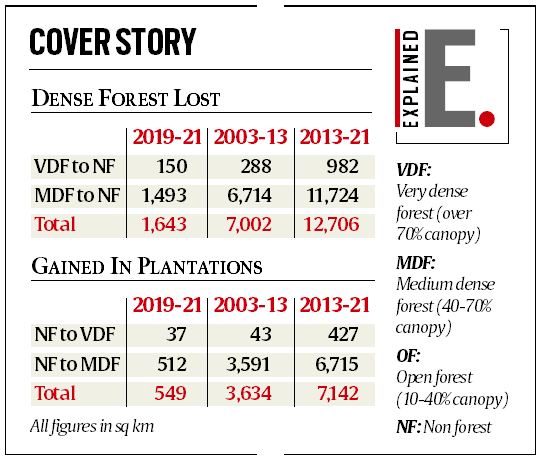Since 2019, loss in dense forests higher than gain in net cover

Releasing the biennial India State of Forest Report (ISFR) 2021 that recorded an overall gain of 1,540 sq km of forests since 2019 on Wednesday, Environment Minister Bhupender Yadav emphasised on “maintaining the quality of forest” as the government’s top priority. The report, however, testifies to the continuing loss of natural old-growth forests across the country.
While Andhra Pradesh, Telangana, Odisha, Karnataka and Jharkhand contributed the most to the national gain in forest cover, and the Northeast reported the biggest losses, the numbers in ISFR 2021 add up to a total destruction of 1,643 sq km of dense forests, which have become non-forests since 2019.
Over one-third of this loss has been compensated by conversion of 549 sq km of non-forest (canopy density below 10%) areas to dense forests (canopy density over 40%) since 2019. These are plantations of fast-growing species since natural forests rarely grow so fast.
Since 2003, when “change matrix” data were first made available, 19,708 sq km — more than half of Kerala’s landmass — of dense forests have become non-forests in the country. The decadal rate of this destruction of quality natural forests has more than doubled from 7,002 sq km during 2003-2013 to 12,706 sq km since 2013 (see chart).
On paper, much of this loss has been offset by fast-growing plantations as 10,776 sq of non-forest areas became dense forests in successive two-year windows since 2003, nearly two-third of that (7,142 sq km) since 2013.
Among the five states that recorded maximum overall gain in forest cover since 2019, Andhra Pradesh, Odisha and Karnataka show a net loss in dense forests (see chart). While Jharkhand maintained status quo, Telangana claimed a significant increase (348 sq km) in dense forest cover.
The trend persists among the top five losers. While Arunachal Pradesh (418 sq km) and Manipur (158 sq km) lost more dense forests than open forest patches, neighbouring Nagaland, Mizoram (86 sq km each) and Meghalaya (36 sq km) also recorded significant losses of dense forests.

Other big losers of dense forests include Madhya Pradesh (143 sq km), Jammu and Kashmir (97 sq km), Assam (66 sq km), Uttar Pradesh (41 sq km) and Tripura (31 sq km). Besides Telangana, Chhattisgarh (81 sq km), West Bengal ( 66 sq km) and Maharashtra (30 sq km) recorded significant net gain in dense forests.
Overall, the forest cover has increased to 7,13,789 sq km, or 21.71% of India’s geographical area. Including the tree cover outside recorded forest areas on plots of less than one hectare, the total green cover now stands at 8,09.537 sq km (24.62%). India remains one of the top 10 countries in terms of forest cover, with Brazil leading the pack at 59.4%, followed by Peru at 56.5%.
Releasing the report, minister Yadav said as many as 17 states now had 33% forest cover. “There has been an increase in mangroves as well, which is encouraging as they are extremely important for the protection of coastal areas from natural calamities like cyclones… The forest produce inventory is also being prepared and will be introduced soon.”
Since 2019, the area under mangroves has increased by 17 sq km to 4,992 sq km, and the tree cover by 721 sq km. Of 52 tiger reserves, 20 have recorded an increase in forest cover since 2011. Overall, the forest cover in tiger reserves and corridors declined by 22.6 sq km (0.04%). Buxa, Anamalai and Indravati reserves have shown an increase while the maximum loss has been in Kawal, Bhadra and the Sunderbans.
The report puts the total carbon stock in the country’s forests at 7,204 million tonnes — an increase of 79.4 million tonnes compared to 2019. It also identifies 35.46% of the forest cover as prone to forest fires.
ISFR 2021 attributed the gain in forest cover or improvement in forest canopy density to “better conservation measures, protection, afforestation activities, tree plantation drives and agroforestry” while it held shifting cultivation, felling of trees, natural calamities, anthropogenic pressure and developmental activities responsible for the loss, particularly in the Northeast.
The report, however, “does not make any distinction between the origin of tree crops (whether natural or manmade)”, and “all the tree species along with bamboos, fruit bearing trees, coconut, palm trees etc” on plots of 1 hectare and above and with “canopy density of more than 10 per cent” are included as forest cover.

